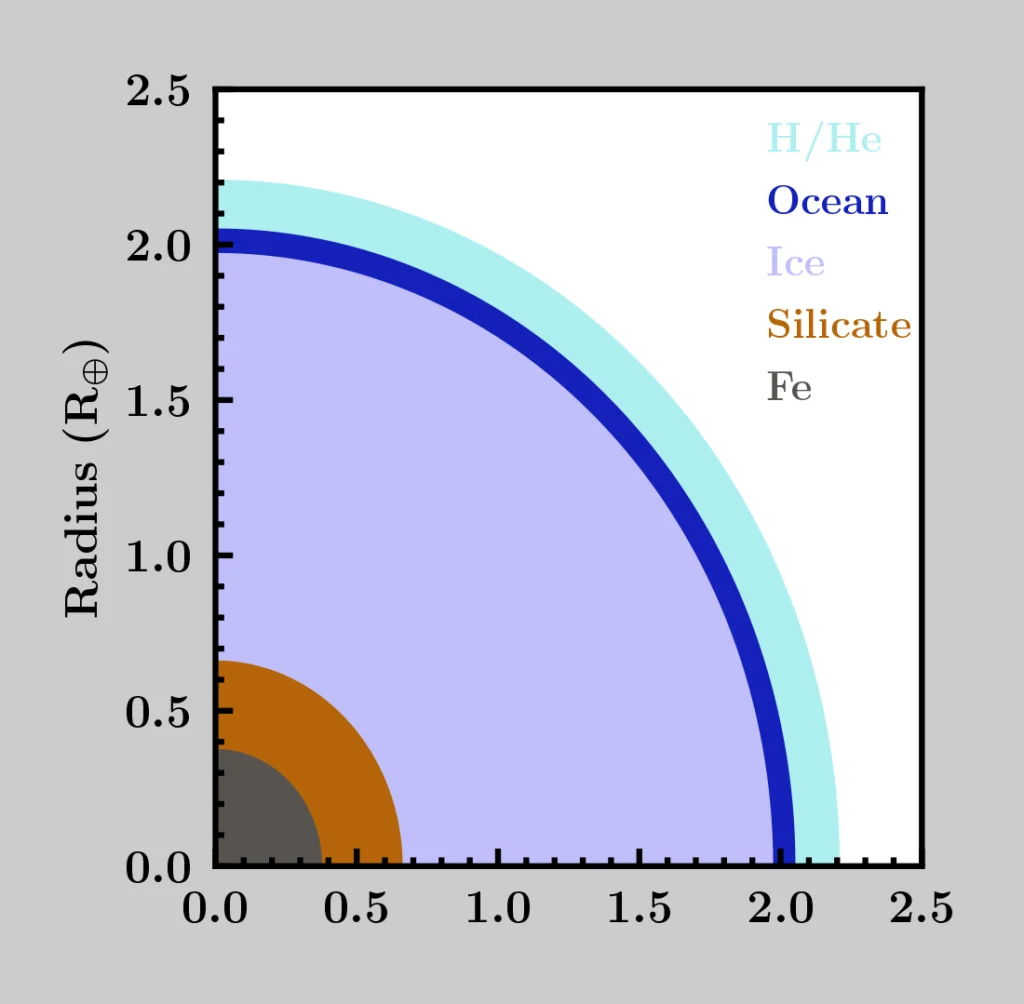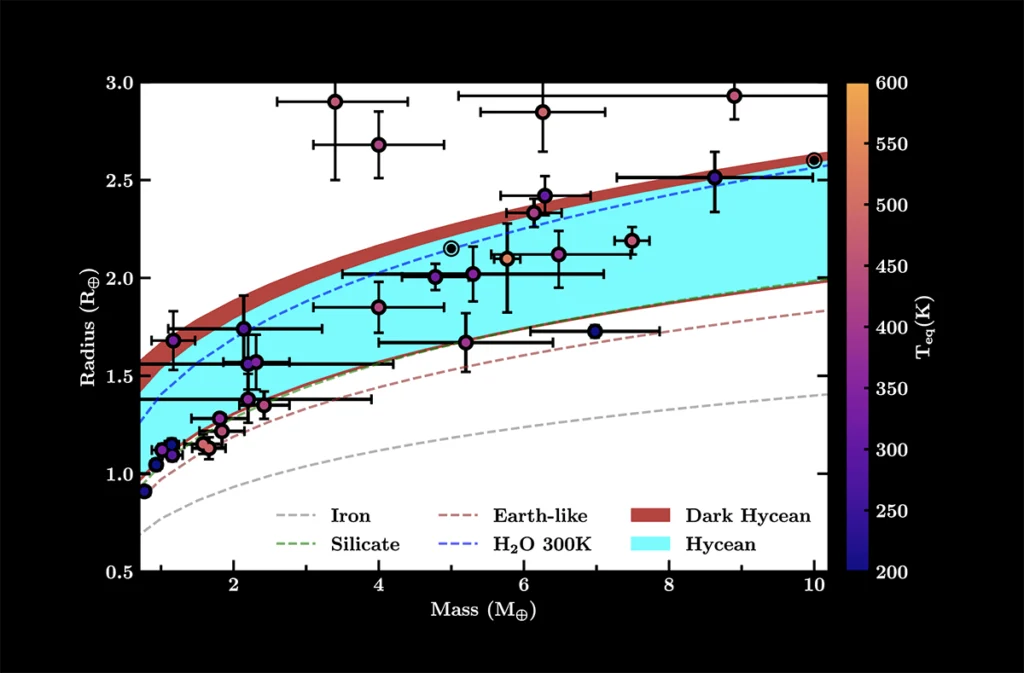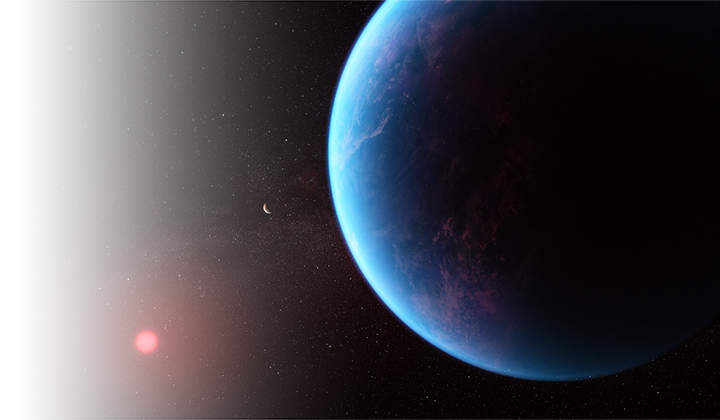The interior of a planet refers to the bulk of the planet beneath the atmosphere.
Understanding a planetary interior is important for assessing its overall chemical composition, structure, geophysical processes, surface conditions, surface-atmosphere interactions and potential for habitability. Although we cannot directly observe an exoplanet interior, important insights can be obtained by exploring theoretical models of possible internal structures that can explain the measured masses, radii and atmospheric properties.

Sub-Neptunes
Sub-Neptunes are planets with sizes between those of Earth and Neptune, whose diameter is 4 times larger than Earth’s. Hycean worlds are a subclass within temperate sub-Neptunes, i.e. with equilibrium temperatures below about 400 K (127 °C). Based on the mass and radius measurements, three types of internal structures are possible for temperate sub-Neptunes (Madhusudhan et al. 2020): a mini-Neptune, a gas dwarf or a hycean world. The mini-Neptune and gas dwarf scenarios both involve deep H2-rich atmospheres, with total pressures over 1000 bar. Beneath the H2-rich envelope, a gas dwarf is expected to be predominantly rocky, while a mini-Neptune is expected to have a significant component of volatiles, such as high pressure H2O, in addition to a rocky core. A hycean world is expected to have a less-massive H2-rich atmosphere over a water-rich interior, with a liquid water ocean on the surface.

Usually, all three scenarios can explain a given mass and radius of a candidate hycean world. However, each scenario predicts a different atmospheric composition due to different interactions between the interior and atmosphere. Therefore, atmospheric observations are used to distinguish between the three scenarios, as discussed here. Our work explores all these aspects of possible hycean worlds, and sub-Neptunes in general, using a combination of atmospheric and internal structure models and state-of-the-art astronomical observations.
Hycean Mass-Radius Plane

Hycean planets can have a wide range of masses and radii, with radii between ~1-2.6 times Earth radii. The figure shows the range of masses and radii possible for hycean planets, referred to as the hycean mass-radius plane. The dashed lines show where planets of different compositions would appear on the diagram: gray indicates a density corresponding to 100% iron; green indicates 100% rock; brown Earth-like, and blue, pure water at room temperature and pressure. The cyan shaded region indicates densities consistent with regular hycean planets, and the red one those consistent with a special subclass of hyceans known as “dark hyceans” (see Madhusudhan et al. (2021) for more details). Black circles show exoplanets with estimated masses and radii, with the uncertainties on these. They are color-coded by their equilibrium temperatures, which are rough estimates of their average atmospheric temperatures.
Hycean Interiors

Hycean worlds are characterised by the presence of a liquid water ocean at the surface, underneath an atmosphere dominated by hydrogen. These planets can contain large amounts of water in the interior with important consequences for their internal structure. Depending on temperature and pressure, water can be vapour, liquid or solid. In particular, when the pressure in the interior becomes very high, water will turn into ice even at high temperatures, as shown in the water phase diagram. The large mass of water contained in hycean interiors means that the water becomes compressed to form solid ices, below the surface ocean. These are known as high-pressure ices, which have different crystal structures and properties to low-pressure ice, which we see on Earth.
Hycean Oceans
The internal structures of hycean worlds, and water worlds in general, also lead to important consequences for the nature of their oceans, as explored in our recent works (Nixon and Madhusudhan 2021, Rigby and Madhusudhan 2024). The oceans of hycean worlds can be hundreds of kilometres deep, potentially up to 1000 km depending on the precise conditions of the planet. In comparison, the deepest point of Earth’s ocean is only around 11 km, with most of the ocean around 5 km deep. Aside from the depth, another major difference between our ocean and a hycean ocean is the ocean base. On Earth, the ocean is directly in contact with the rock below. However, on hycean worlds, the high-pressure ice layers separate the ocean from the rock below, possibly inhibiting the usual rock-water interactions seen on Earth.
Receive Email Updates
As we add news and content to the website, we'll email you to keep you updated!


